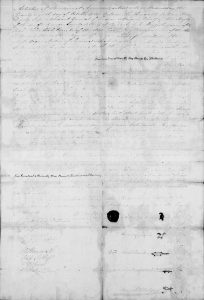In addition to their three small reserves located on the Lake Ontario shoreline, the Mississaugas of the Credit held 648,000 acres of land north of the Head of the Lake Purchase lands and extending to the unceded territory of the Chippewa of Lakes Huron and Simcoe. In mid-October, 1818, the Chippewa ceded their land to the Crown in the Lake Simcoe-Nottawasaga Treaty and, by the end of October, the Crown sought to purchase the adjacent lands of the Mississaugas of the Credit.
 The Deputy Superintendent of the Indian Department, William Claus, met with the Mississaugas from October 27-29, 1818, and proposed that the Mississaugas sell their 648,000 acres of land in exchange for an annual amount of goods. The continuous inflow of settlers into their lands and fisheries had weakened the Mississaugas’ traditional economy and had left them in a state of impoverishment and a rapidly declining population. In their enfeebled state, Chief Ajetance, on behalf of the assembled people, readily agreed to the sale of their lands for £522.10 of goods paid annually.
The Deputy Superintendent of the Indian Department, William Claus, met with the Mississaugas from October 27-29, 1818, and proposed that the Mississaugas sell their 648,000 acres of land in exchange for an annual amount of goods. The continuous inflow of settlers into their lands and fisheries had weakened the Mississaugas’ traditional economy and had left them in a state of impoverishment and a rapidly declining population. In their enfeebled state, Chief Ajetance, on behalf of the assembled people, readily agreed to the sale of their lands for £522.10 of goods paid annually.
On October 28, 1818 the Crown and the Mississaugas, signed Treaty 19, also known as the “Ajetance Treaty”, which ceded 648,000 acres of land (all lands north of modern Eglinton Avenue). Treaty 19 was signed by William Claus, Deputy Superintendent General of Indian Affairs on behalf of the Crown and Mississauga Chiefs Adjutant (Ajetance), Weggishgomin, Cabibonike, Pagitaniquatoibe and Kawahkitahaquibe. The agreement was witnessed by James Givins, Superintendent of Indian Affairs, William Hands Jr., Clerk of the Indian Department, and William Gruet, Interpreter for the Indian Department.



Comments are closed.